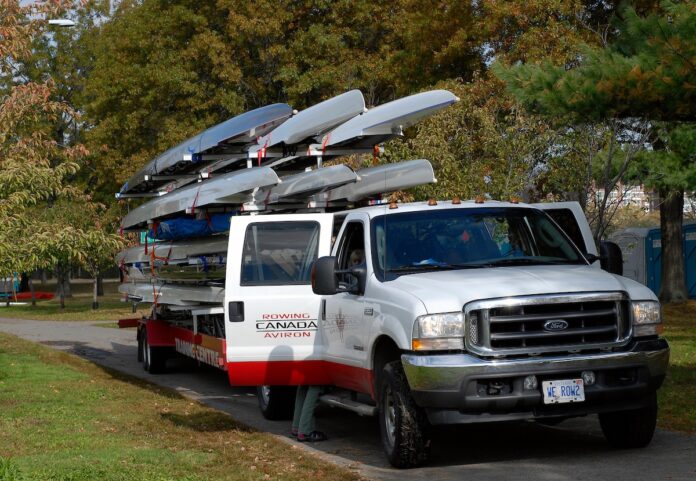BY NANCY CLARK | PHOTO BY PETER SPURRIER
To continue reading…
Register for free to get limited access to the best reporting available.
Free accounts can read one story a month without paying.
Register for free
Or subscribe to get unlimited access to the best reporting available. Subscribe
To learn about group subscriptions, click here.
Already a subscriber? Login
Many rowers, coaches, athletic trainers, and support crews—including parents, partners and siblings—spend a significant number of mealtimes on the road, traveling from one rowing event to the next, be they training sessions or regattas. Questionable sports meals and snacks are so readily available at gas stations and convenience stores that it can weaken one’s will to search elsewhere for more nutritious fare.
Without a doubt, adhering to a decent sports diet becomes a challenge when healthy food options are scarce. Nevertheless, rowers who travel by car deserve to be fueled optimally so they can perform at their best. That means being creative—and planning ahead.
Bigger gas stations and those closer to a main highway or busy town tend to offer more nutrient-dense food than small-town gas stations where the shelves are stocked with candy bars and bags of pork rinds. Hence, you (or the team’s driver) should keep nutrition in mind when planning fuel stops. Getting gas sooner at a bigger station is better than later, if later will be in the middle of nowhere.
Eating well on the road
A “well-balanced sports diet” includes foods from at least three, and ideally four, of these groups:
1. Fruits and vegetables for vitamins and minerals to boost your immune system and help keep your body healthy.
2. Grain-based foods to fuel your muscles and your brain.
3. Protein-rich foods to build and repair your muscles.
4. Calcium-rich foods, such as dairy, to enhance bone health and provide high-quality protein for muscles.
“Well-balanced” applies to your entire day’s eating and not just one meal or snack. Therefore, a good breakfast, lunch, and dinner can offset sub-optimal snacks. “Balance” also includes calorie balance. By reading the calorie information on food labels, you can determine the portion size that fits your calorie budget to avoid undesired weight loss or gain. Approximate targets: at least 600 to 800 calories per meal for female rowers, and 800 to 1,000 calories per meal for males.
The above chart of some typical gas-station snacks organizes the foods according to nutrient profile. Using this template, you can manage to pick a somewhat balanced, halfway decent sports diet when you’re on the road (or at a vending machine). Remember: at least three of the four kinds of food for meals, and two kinds for snacks
** If you are lactose intolerant, cheddar cheese is a lactose-free dairy option, but you’ll probably want to travel with Lactaid pills. Non-dairy calcium-rich foods such as soy milk or calcium-fortified orange juice can be harder to find on the road. Calcium-fortified almond milk might be available, but besides offering calcium, it’s a nutrient-poor choice.
Turning convenience foods into a balanced sports diet
When you’re at home, a well-balanced diet that includes all four food groups might look like this:
•Granola + milk + banana + hard-boiled eggs
•Whole wheat bread + turkey + cheese + lettuce/tomato and an apple
•Brown rice + chicken + broccoli + yogurt (for dessert)
When you’re eating from the gas station/vending machine, your balanced diet might resemble these tasty meals:
•Orange juice + popcorn + protein bar + yogurt
•Salsa + corn chips + almonds + milk
•Banana + peanuts + Wheat Thins + cheese sticks
Fresh fruits and vegetables can be the hardest foods to find when you’re on the road. You will not suffer from malnutrition if your traveling diet is low in fruits and veggies for a week or so because your body stores their vitamins in the liver. A healthy person’s liver stores enough vitamin C to last for at least three weeks. But you’ll want to restock your liver’s diminished supply when you return home. That means enjoying extra fruit smoothies, colorful salads, and generous portions of fresh fruits and veggies whenever you get the opportunity to do so.
Traveling with a cooler
A wise alternative to “dining” at gas stations is to travel with a cooler (and refreezable ice packs). Stock the cooler with sandwiches (PB&J, ham & cheese), water, 100-percent orange juice, chocolate milk boxes, and other wholesome sports foods. A pre-trip food-shopping spree at a BJ’s, Costco, or large supermarket can save a team a lot of money. Some suggestions:
Perishable items: Oranges, orange juice, baby carrots, peppers (eat them like apples); yogurt, sliced cheese, milk chugs; ham, hard-boiled eggs, hummus; tortillas, wraps, mini-bagels.
Non-perishable items: tuna in pop-top cans, small jar of peanut butter, almonds; granola bars, graham crackers, Fig Newtons, dried fruit, V8 juice.
Note: Your teammates may come begging for food from your personal cooler, so pack extra or, better yet, encourage them to pack their own food!
The Bottom Line
Performance begins with good nutrition. If you make the effort to travel to rowing events, you want to make the effort to eat a winning sports diet. No amount of training will override a poorly fueled athlete.

